July 24 – Aug 11, 2020
Rafting the Colorado River through the Grand Canyon on a private permit is a major undertaking. I was not the permit holder, but I still spent months doing research and preparing for this epic adventure. While this report will cover some of what we did, I hope to focus on how to prepare for such a trip. During my research, I found information sparse and hard to come by. I will let my videos and my daughter’s blog tell the rest of the story. For more information about the trip itself, check out Jamie’s blog.
We had twenty people in our group, sixteen at a time, with six boats. Four people hiked out at Phantom Ranch while four others hiked in to replace them. All boat captains other than my daughter and myself have run the Grand previously. It was all new to our family. Our permit holder has run the Grand six or seven times, and one captain used to be a river guide on the Grand. Their knowledge of the river and their advice was greatly appreciated. They knew how to run each rapid, where to stop for cool side hikes, and which camps got early shade.
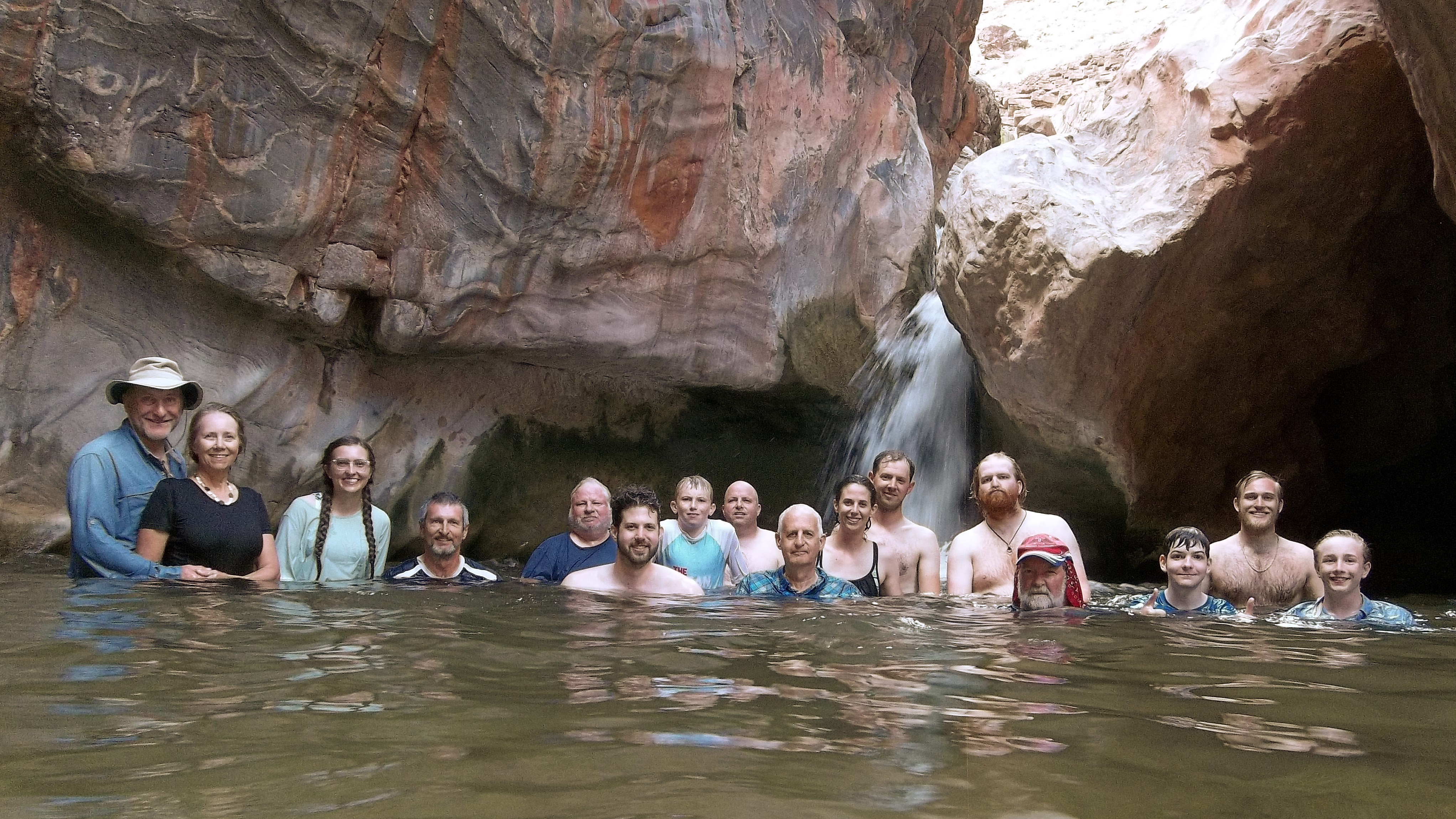
Videos
Check out my YouTube channel for videos and slideshows.
Rafts & River Equipment
Many people use 18’ rafts for a private trip. There are outfitters from which you can rent the boats. You can even rent a fully rigged and loaded boat, complete with 18 days of food.
All of the boat captains in our group own their own gear, so most of us used 16’ rafts. We had four 16’ rafts, one 15’ raft, and one 16’ cataraft. It is a challenge to fit all of your food and gear in the smaller boats, but with only two or three people per boat, it worked out well. It was, however, a challenge to find things in the dry boxes because they were so full – at least until you ate up some of your food supplies.
In addition to a quality raft, you certainly need a good repair kit and first aid kit. You also need two spare oars, a spare PFD for every ten people, and enough toilet tanks for such a long trip. It is good to have a spare stove and multiple propane tanks.
We used electric water filters to refill our water jugs every other day or so. Each boat needed to carry between five and ten gallons of water. Since our trip was during the heat of the summer, everyone had to drink a lot of water to stay hydrated.
Umbrellas or a Bimini provide much desired shade while on the river.

We arranged to have motors dropped off at Separation Canyon to help push through those last 40 miles to Pearce Ferry. Rowing through that section would not be enjoyable – especially with an afternoon wind.
Rig to Flip, Dress to Swim
There are plenty of holes and lateral waves that are powerful enough to flip a raft. It isn’t just the ‘big’ rapids. Many people flip in lesser known rapids simply because they aren’t paying attention. As the old saying goes; “there are two types of rafters – those that have flipped, and those that will.” So always secure all of your gear in the boat – including your cooler lid.
During the summer, the heat can be brutal, but the water is very cold – somewhere around 46° at Lee’s Ferry. 46° is bitterly cold – it hurts to get in the water. Hypothermia can set in within a few minutes in the cold water. So, if someone does go overboard, try to recover them as quickly as possible.
The ranger recommended splashing cold water in our faces prior to all major rapids to minimize the shock should you fall in. This may also help prevent heart attacks. For the larger rapids, I put on my hydroskin top and a helmet – just in case.
During the summer, the water warms up as you move down river – maybe by 5° by Phantom Ranch. By the time we arrived at Pearce Ferry, the temperature was quite tolerable.
Fitness
I have had a few opportunities in the past to raft the Grand Canyon, but for various reasons never made it happen. I decided I should do it before I got too old – but since that was probably ten years ago, I decided to go anyway 😉
The global pandemic provided me opportunity to work from home, so I decided to spend the time I saved in commuting to and from work on exercising. I wanted to loose weight and get in better shape to handle long days on the oars.
Just prior to the trip I finished an eight week weight lifting program. The routines included a lot of squats, which really helped prepare me for the side canyon hikes. Many of the hikes were basically like climbing many flights of stairs. The arm, shoulder, and back exercises also helped with my rowing – in particular, forward rowing, which has always been a challenge for me.
Even after long days on the oars, my muscles never fatigued too severely. My primary issue was arthritis in my wrists and elbows. So I welcomed help from Jason, Steve, and Eric – especially during the windy afternoons.
Coolers & Ice
Keeping refrigerated foods fresh is a major challenge. Each boat was assigned approximately three days of meals, all in a row. Those with late assignments needed to keep their coolers closed and sealed until the day they started their food assignment. A quality cooler with about 1/3 ice, 1/3 frozen foods, and 1/3 produce can keep ice for about 12 days in the heat of summer – assuming you cover the cooler with a wet towel and keep it in the shade as much as possible.
Crushed ice won’t last, and store-bought block ice has a lot of air in it, so it isn’t the best. If you don’t have access to a good source of ice, it is best to make your own. I used a 12.5” x 14” x 7” plastic tub to make large blocks of ice for my cooler. I used two of those blocks, and froze all of my pre-cooked meat in smaller tubs. I hoped to also take two one-gallon jugs of ice, but had to leave those home (along with some food) due to limited space. It is tough to estimate how much ice you need, and how much space you will have left for food.
Normally I freeze water in a 3-gallon jug. As the water melts, I have extra water for drinking, and it doesn’t get my food all soggy. But for the Grand, I couldn’t spare the space used up by the jug. I put all of the food in zip lock bags to keep it dry as the ice melted. This did not work out so well. Some of my food got damaged because the zip lock bags leak. Even double bagging didn’t always work. Perhaps a vacuum pack sealer would be worth getting for such a trip.
Do not drain the water from your cooler until your food assignments are complete. The cold water will preserve your food much longer than letting in warm outside air.
A quality cooler is also a must for those later days in the trip. Layne has a Yeti cooler and is able to freeze his entire cooler inside a chest freezer – so he took the last food assignment. I have an Icee-Kool cooler (now obsolete) which is similar to a Yeti, so I took the second to last food slot. I augmented the insulation with foil-lined closed-cell foam about 3/8” thick. I lined the entire inside of the cooler with this foam, and an extra layer on top of the lid. I covered this with an old towel which we tried to keep wet, and covered it with my sleeping pad for additional insulation and shade during the day.
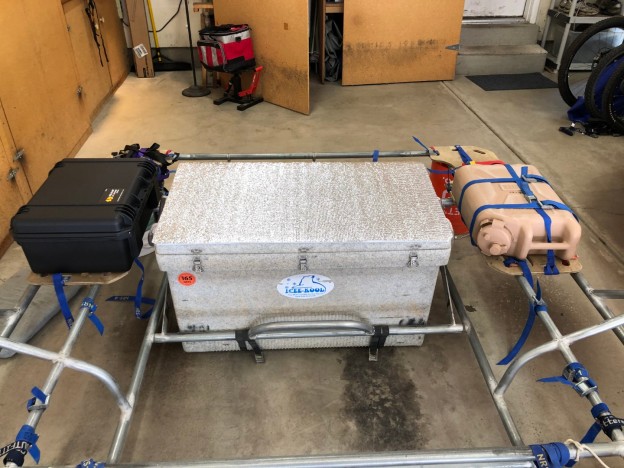
I had to open my cooler early in order to store some of my daughter’s left-over items such as Mayonnaise. This was a mistake. It would have been better to have a second bottle that could remain unopened until needed. When I opened my cooler for my first food assignment on day 12, I only had one small chunk of ice remaining. The water was still cold for another two days, so we barely finished our meal assignments without food spoiling (other than that damaged by water). Layne got similar results. His ice was gone by the time he started his food assignment.
In the future, I would suggest planning non refrigerated foods for the last few days.
This video provides some great advice on packing a cooler:
Food
I often tell people that river trips are like backpacking, except we eat good. Since weight isn’t a major issue, we take Dutch Ovens and firepans and have some wonderful meals.
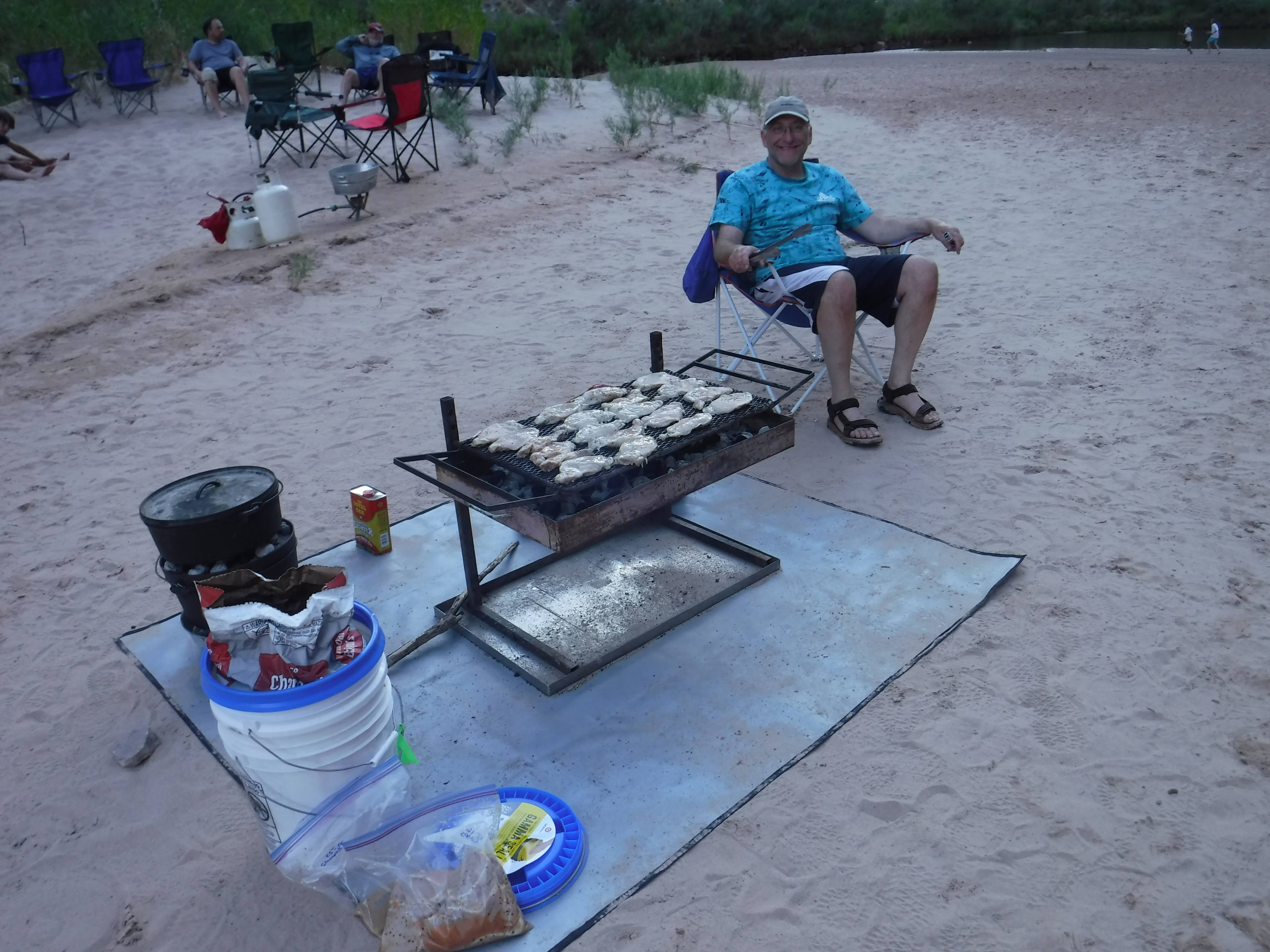
No one likes to waste food, so there is a natural tendency to pull out your leftovers for meals provided by others. The downside is that we ended up eating lunch meat and cheese that had been opened for three or four days even though we had unopened packages in a cooler that was still cold. In the end all leftover food will go into the garbage – so eat the fresh food while you can and just discard the older stuff.
Things like melons taste wonderful on a hot summer day, but they generate a lot of trash that someone has to haul out. Be mindful of how much trash your meals generate. Sometimes the trash ends up bulkier than the pre-cooked food. Leave as much food packaging, such as cardboard boxes, home. It just generates garbage and bulk.
Garbage Management
I prefer to have a small garbage bag for each meal rather than one large one for a day or two of meals. It is easier to find a place to tuck a small bag than a very large one.
Once someone’s meal assignments are over, they can turn their cooler into a large garbage bin.
Each boat provided a five-gallon bucket with a screw top lid. We called this the “icky trash”. Food scraps went in there to help control the stink. These buckets filled up really fast – especially for meals that included melons.
Staying Healthy
Staying healthy is critical. If someone gets sick, it can easily spread to the entire group. Thus, it is important to thoroughly wash your hands regularly and use hand sanitizer. We had a hand wash station near the toilet, and a second near the kitchen.
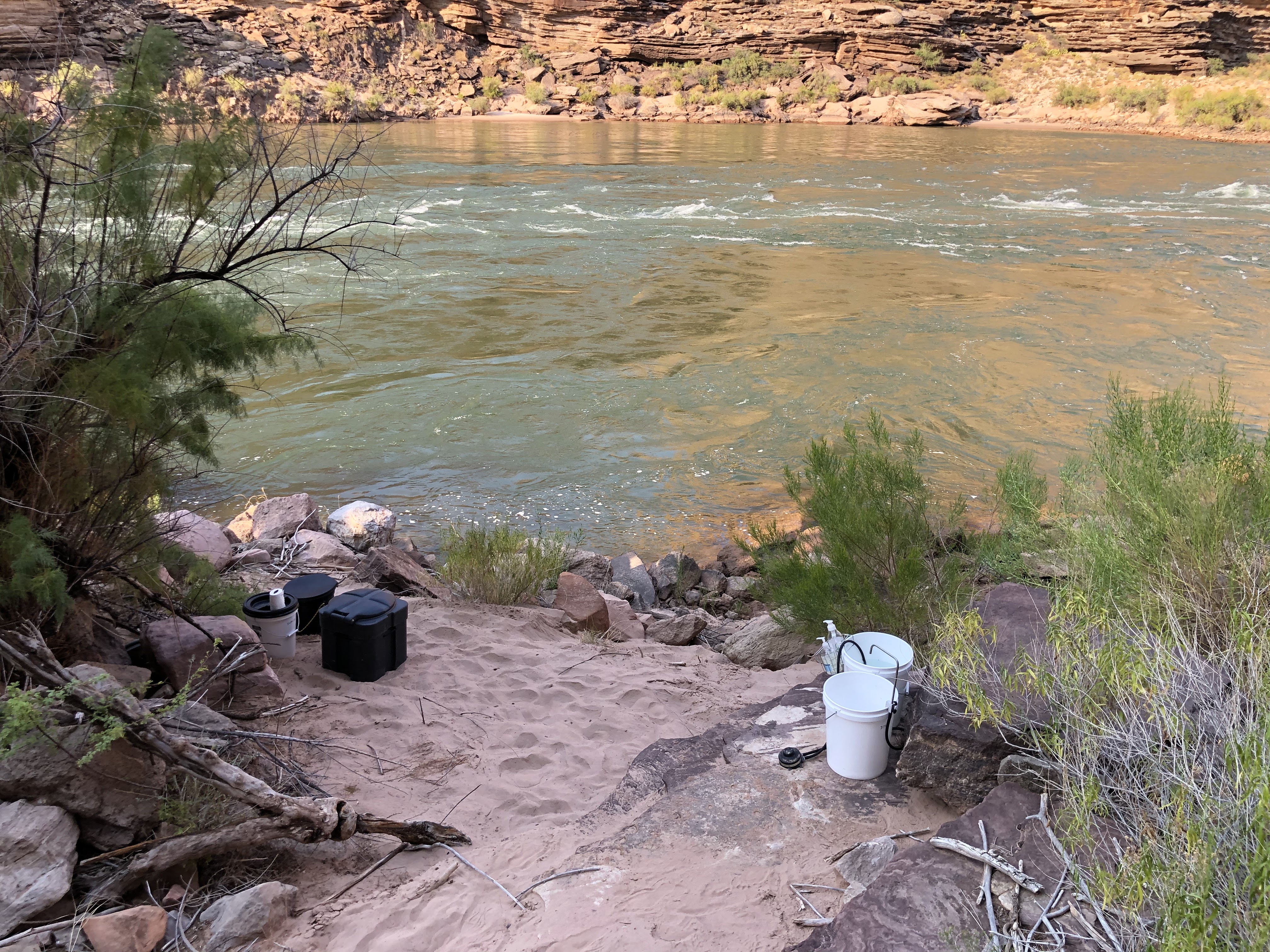
We used a four-bucket dish washing system. Previously I have used a three-bucket system, but the addition of the first pre-wash bucket really helped get our dishes clean. The buckets included; 1) hot pre-wash with soap, 2) hot wash with soap, 3) hot rinse, and 4) cold bleach dip. The icky trash bucket was usually placed near tub #1 so you could scrape your scraps into the bucket.
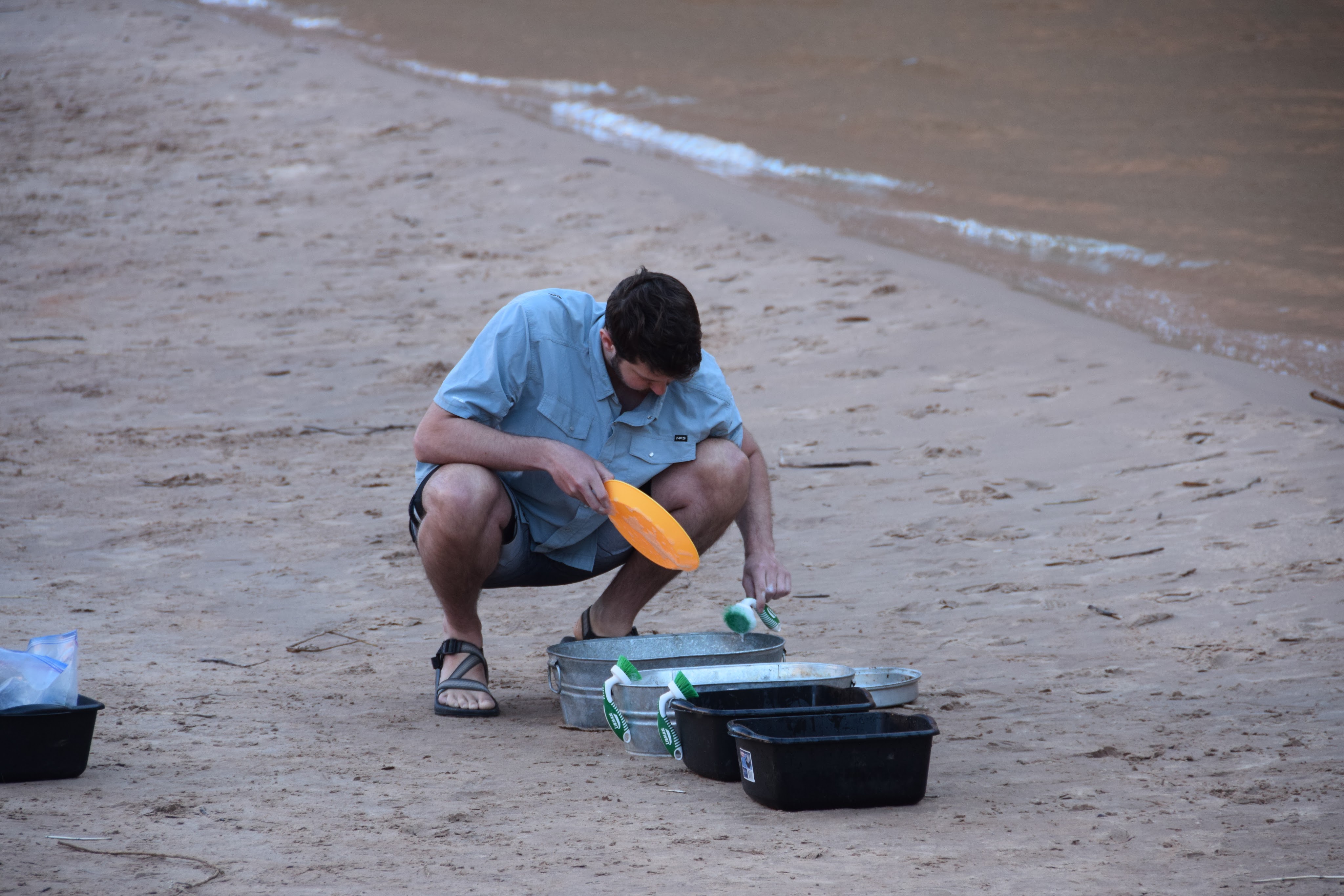
Camping Equipment
During the hot summer, most people prefer to sleep out under the stars. The bugs aren’t too bad, so a tent is generally not needed unless it is stormy. A cot works great to keep you off the hot sand and/or rough ground. A damp sheet or micro-fiber towel work great to keep you cool when you first go to bed. As the sheet dries, the air temperature usually drops, so you can be quite comfortable all night long. On the few nights it got a little chilly, I used a fleece sleeping bag liner. I never had to pull out my sleeping bag.

We also used a large rain fly for shade when we had a camp that didn’t get early shade. The heat can be brutal.
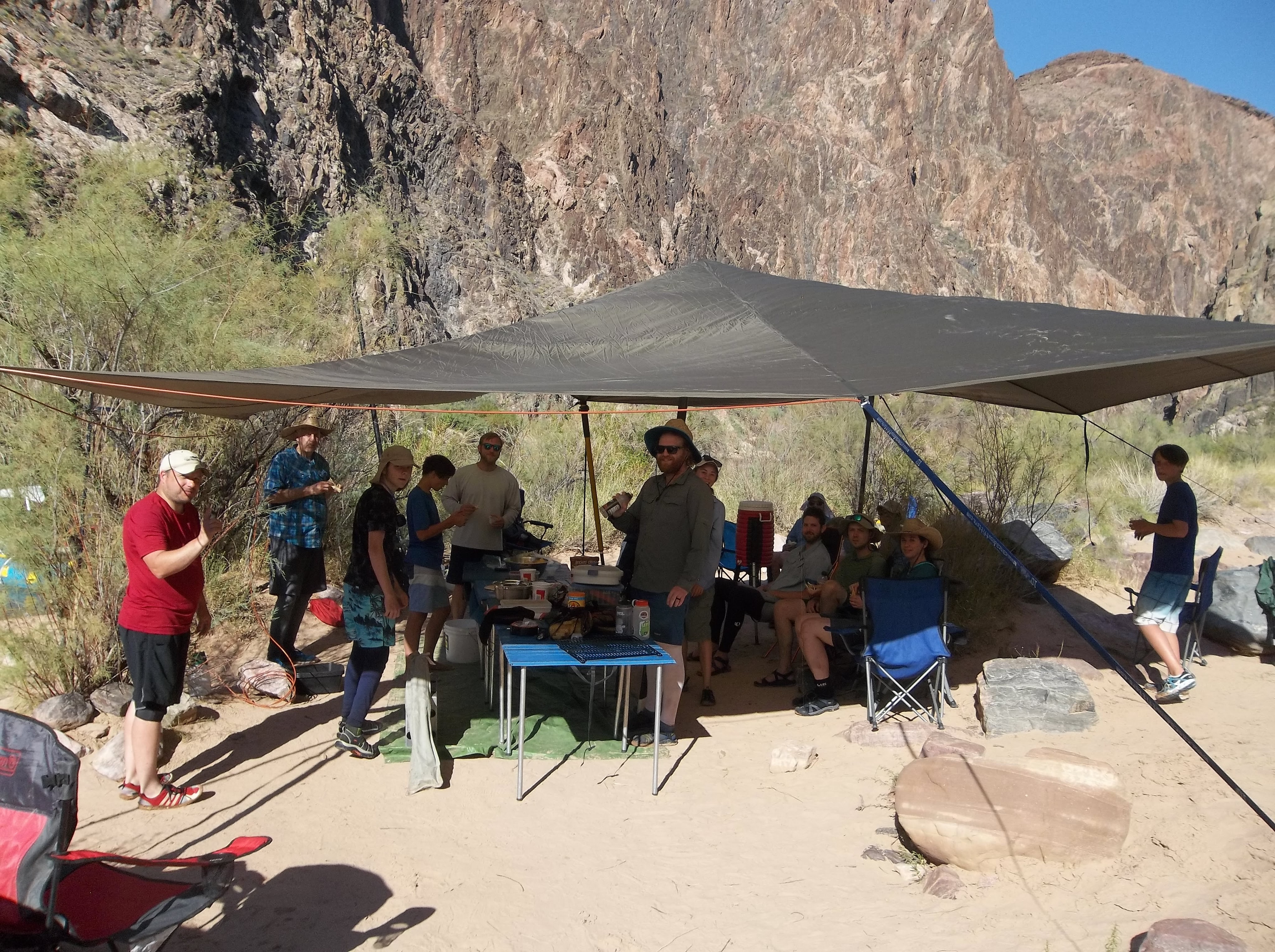
We were also prepared to set up our tent rainfly if needed for personal shade or shelter from the weather. Some people slept in tents, but I found the heat too unbearable to be confined to a tent.

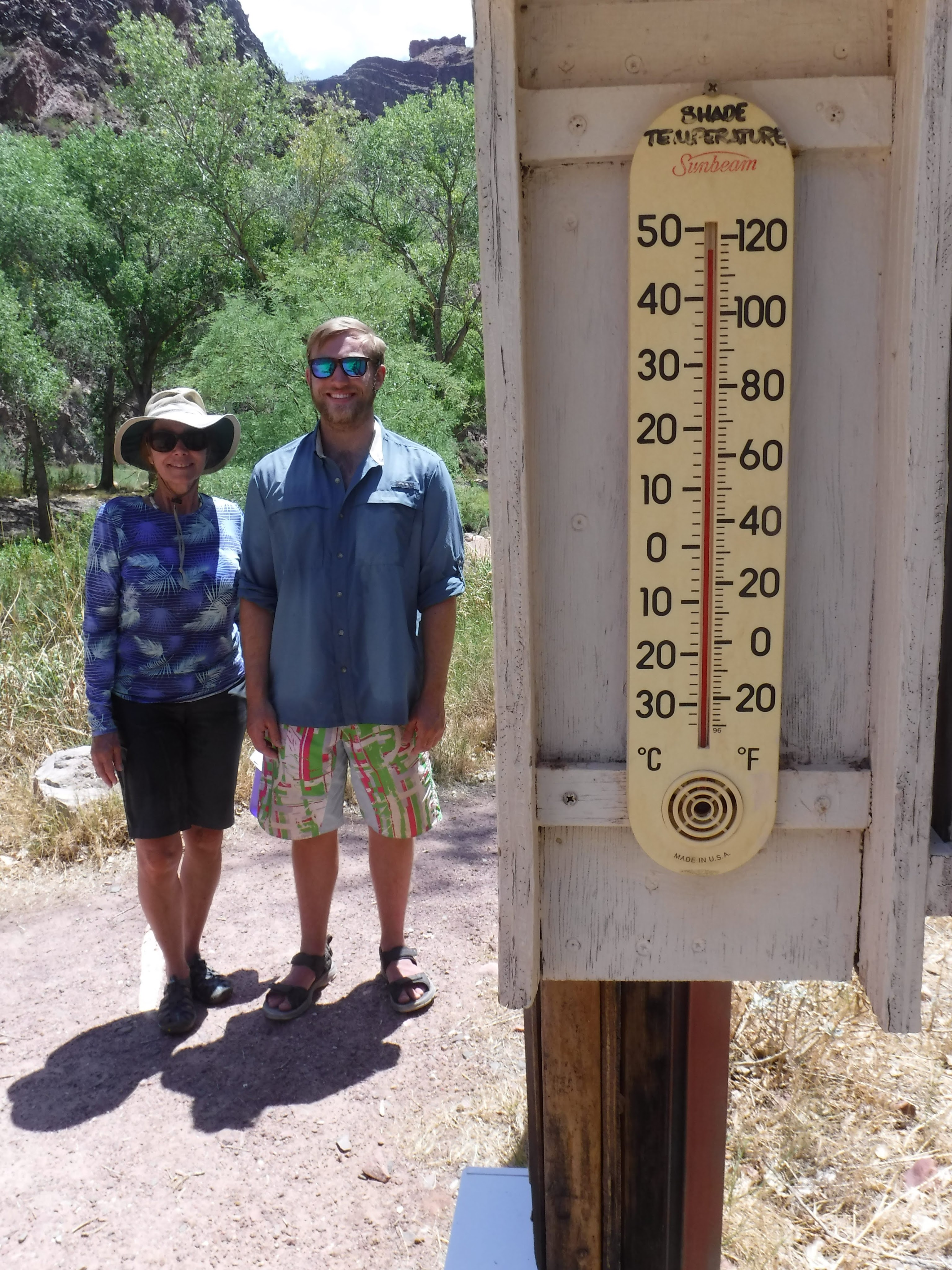
Water Level
One challenge on the Colorado River below Glen Canyon Dam is the vast daily change in water level. I think we had a pretty forgiving water level, but it ranged from about 9,000 cfs to almost 19,000.
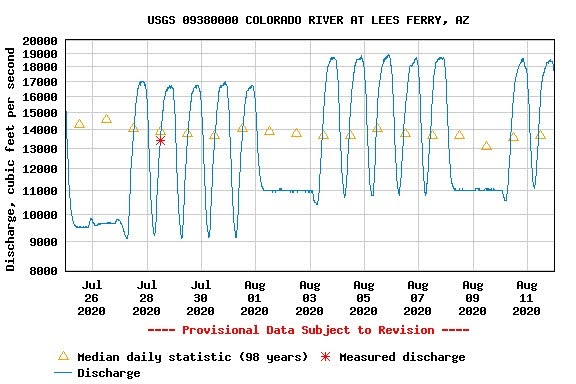
The water was high when we rigged our boats at Lee’s Ferry, but when we woke up in the morning, the boats were all high and dry – about 15’ from the river. At each camp we would have to assess what the river would do during the night. Would it come up? Or would it go down? We would have to secure our boats so that they were hopefully still in the water in the morning. It takes roughly three days for the water to flow through the canyon, so you can estimate what the water will do based on where your camp’s river mileage. Peak flows occur on weekday afternoons when electrical demand is highest.
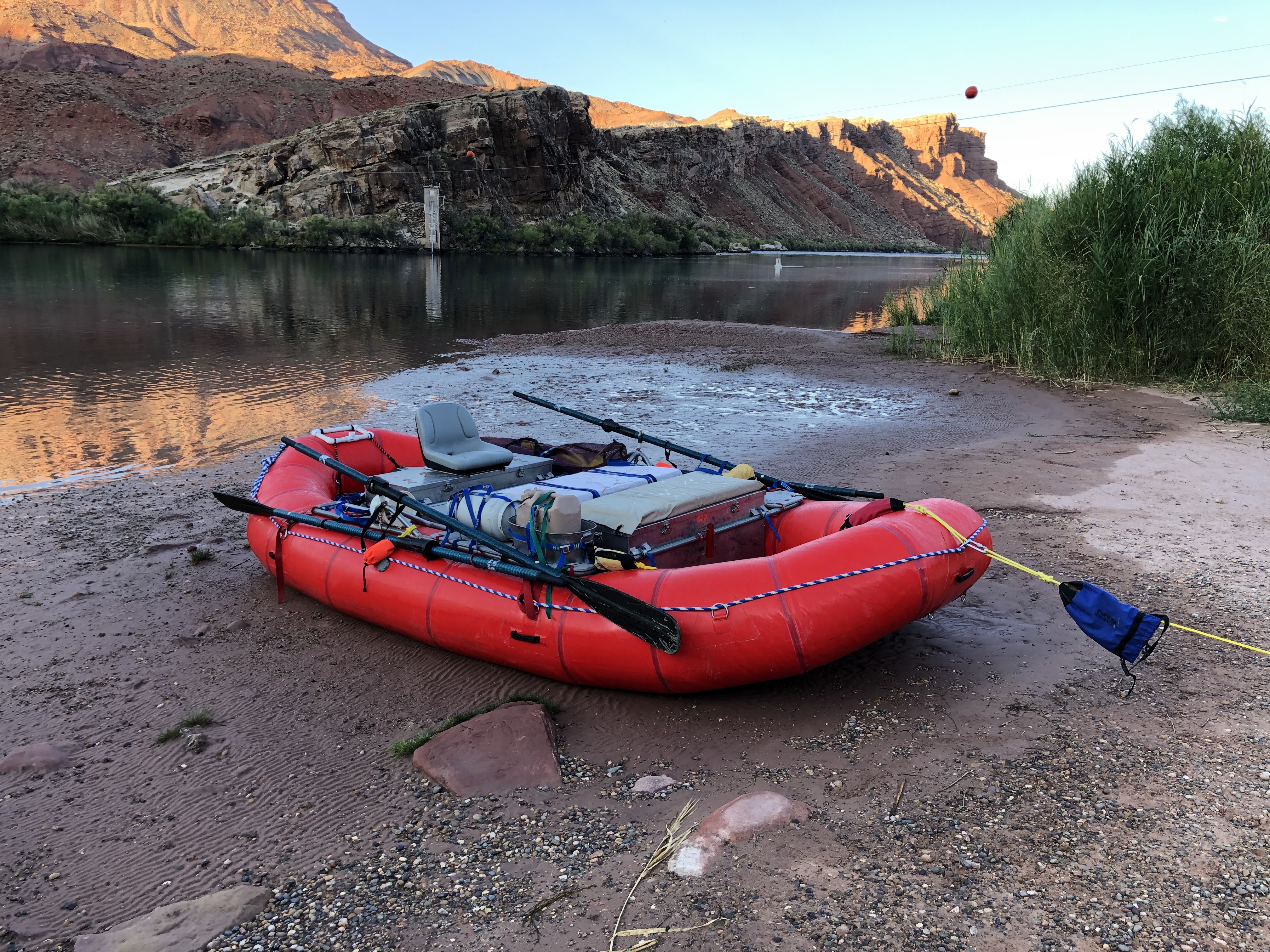
Rapids
There are hundreds of rapids in the canyon. Most of them are small “read and run” type rapids. Many of them are really fun, but it is a shock when that cold-water hits you.
There are, however, a handful of highly technical rapids that require critical moves within the rapid. These rapids are extremely fast, and extremely powerful. Since I have never before rowed through rapids of this magnitude, it was difficult to time my moves and have sufficient power to move the heavily loaded boat where I wanted to go. I did well on some rapids, but poorly on others. Luckily, no one in our group ever flipped – but we did have some close calls.
Many of the rapids in the Grand Canyon have a lot of strong lateral waves that bounce off the cliff. It is important to hit them square on, or your 16’ boat turns into a 7’ boat, which is much more likely to flip.
There are also a lot of strong Eddies throughout the canyon. It takes great skill to thread your way through without getting stuck for a time.
House Rock
House Rock has two very deep holes at the bottom on the far left. The current pushes into the cliff on the left side, so you have to continually pull right. It is okay to just skirt the right edge of these holes. This will be your first exposure to the speed and power of the big rapids – and the water is super cold here since you are probably only on day two.
Hance
Hance is long and full of holes and rocks. The worst is along the right side – where most of the current goes. The typical run is to enter just right of center, but ferrying left throughout the rapid. I completely misjudged the entrance and ended up having a wild ride down the right side through massive waves and holes. Since I didn’t flip, it was really a run ride.

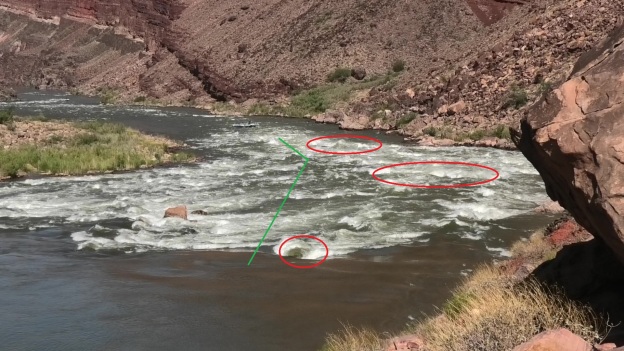
Sockdolager
Sockdolager may have been everyone’s favorite rapid. At this water level, it was just big, fun waves.
Horn Creek
Horn Creek has some nasty lateral waves on the right side that can flip boats. I entered just right of the right horn and had a great ride through massive waves. Super fun.
Granite
Granite also has large lateral waves coming off the cliff on the right. At our water level it was a pretty easy run, but those lateral waves can flip boats.
Hermit
Hermit isn’t as big as it used to be (so I am told), but it still has some really big waves. Wave #5 is the largest, and sometimes has a curler on top that can flip boats – so you may want to stop and scout (and take photos).
Crystal
Crystal has a huge and powerful hole just right of center. There is another hole on the far left, and the left side piles into the cliff – making a left sneak risky. Most people opt for a right sneak bumbling along the shallow waters near shore. But be warned – the current sucks you right back towards the hole.
James decided to just run straight down the tongue. I think he had the easiest run – and the best ride. The current took him just left of the big hole for a good ride through the wave train. I should have taken that route.
Ian went down the far-left side. He was able to pull away from the cliff at the bottom in his cataraft.
The rest of use took the right sneak – or tried to. I barely made it right of the hole. The nose of my boat skirted the hole, but we were far enough right to not be at risk of flipping. Jamie thought she was far enough right until the last second when she realized that she was heading straight into the deepest part of the hole. She barely had time to spin the boat head on, and Steve managed to move to the very front of the boat. They got a wild ride and almost flipped end over end. This may have been the highlight of the trip – at least the most exciting moment.

Just below the main rapid is a rock garden and island. It is generally easiest to go right, but the current looks deceiving and may entice you to try and go left. It is easy to get stuck on the rocks if you don’t pull far enough left.
Bedrock
Bedrock has a massive rock in the river with most of the current going to the left – but you want to go right. It is a hard pull to go right, but that is the safest run. If you don’t pull hard enough, you could pin or flip on the rock, or you may get washed down the left side for a nasty ride and a good chance of pinning or flipping. This rapid doesn’t have fun waves like the others – you just don’t want to miss the right slot.
Upset
Upset has a large and wide hole near the bottom. The typical run is down the left edge where the waves are powerful and turbulent as they bounce off the cliff. There is a possible right sneak, but it is hard to make. I ended up hitting the hole, but it collapsed just as we hit it – so the hole ended up being the smallest wave in the rapid. Jamie hit the hole backwards and was able to punch through okay.
Lava Falls
Lava Falls brings fear into the hearts of river runners – even those that have run it multiple times. But I found it was actually a pretty easy run. You just have to trust the bubble line. If you line the tail of your boat on the left edge of the bubble line approaching the rapid, it will take you right into the “tea cup”, which is the safest entry for the rapid. From there just try to work left and keep your boat straight when you hit the big waves – especially Kahuna near the bottom.
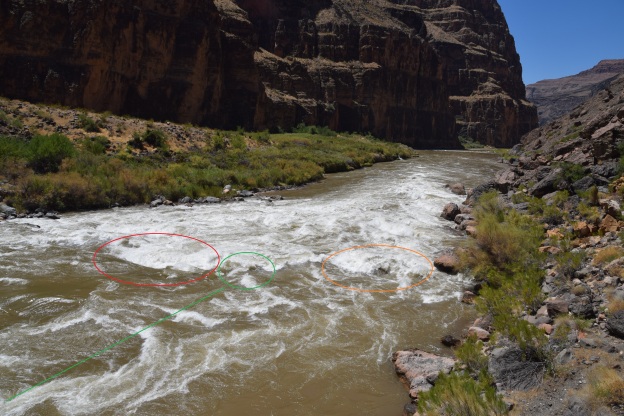
If you enter too far right, you are in for a wild ride through several massive waves and holes, and the really big kahuna near the bottom. You also risk getting stuck in the small Eddy just right of “cheese grater rock”.
If you enter too far left, you will hit the “ledge hole”. This is one mean and nasty hole that you don’t want to mess with. It can totally destroy your boat, and I suspect there is a high risk of drowning. I ended up catching the right edge of the ledge hole. It spun our boat around and started pulling us back in, but we were able to break free. I think the wind blew us left as we came down the tongue. If you look closely in my video you can see my boat move left while everyone else’s moved right with the current. That was a scary moment.
232 (Killer Fang Falls)
Killer Fan Falls has some nasty rock spires near the bottom of the wave train. You really need to move left of the wave train or risk getting pinned. At many water levels you can’t see the rocks until it is too late. We couldn’t see them at all.
Side Hikes
It is amazing how many wonderful side hikes, slot canyons, and waterfalls there are to explore in the canyon. We explored many of them. The only one I would suggest skipping in the heat of the summer is the 3.5-mile hike to Thunder River. It is brutal in the heat. If you do go, be sure to take a water filter to refill your water bottle.
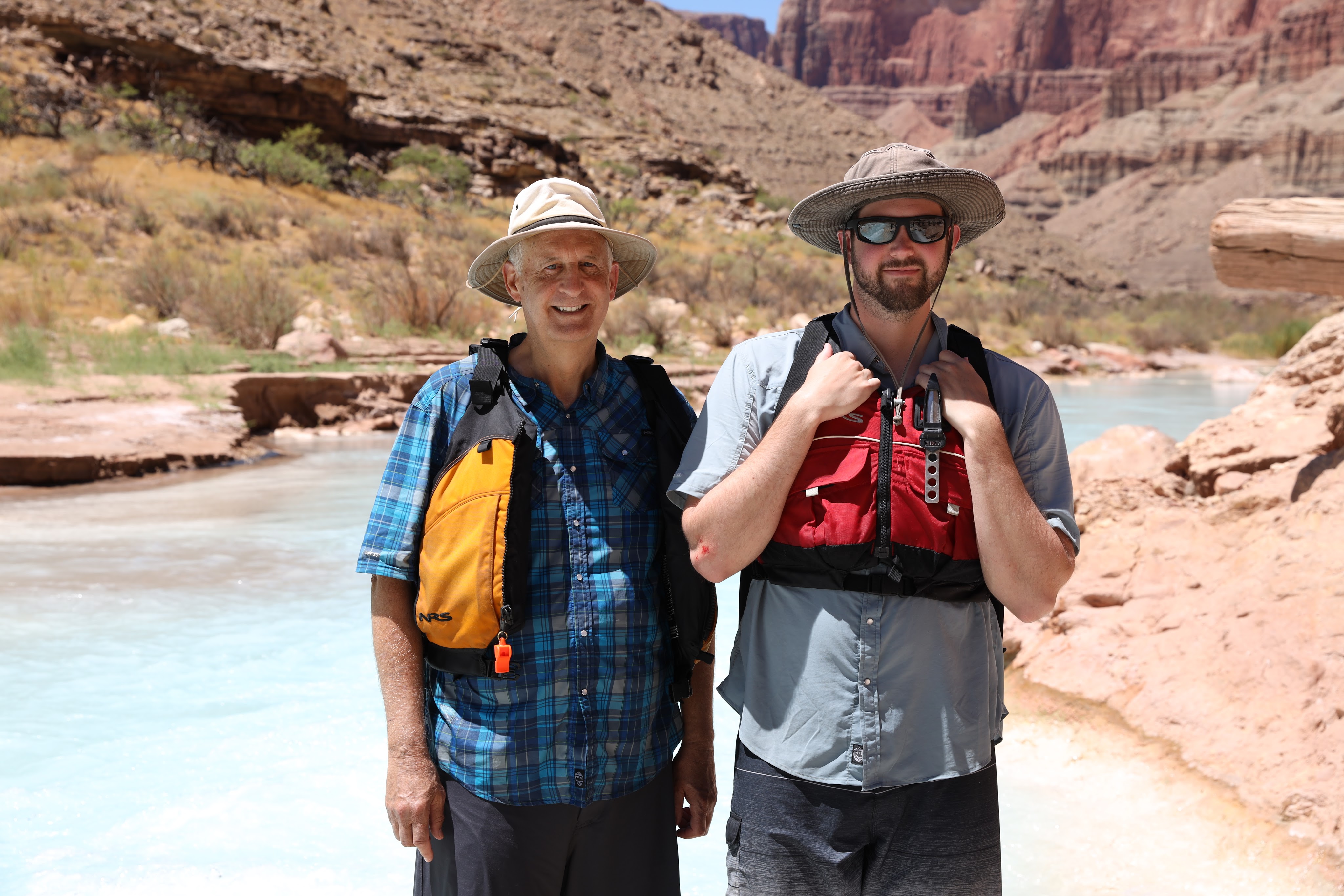
Trip Notes
| Day | Date | River Mile | Comments | Miles Traveled |
| 0 | July 24, 2020 | 0.0 | Breakfast at home | |
| Nail in trailer tire | ||||
| Ice cream cones | ||||
| Rig rafts | ||||
| Navajo Bridge | ||||
| Dinner at Marble Canyon Lodge | ||||
| Rain storm & rainbow | ||||
| 0.0 | Slept in long term parking lot | 0.0 | ||
| 1 | July 25, 2020 | 0.0 | RM breakfast – bagels, | |
| Ranger lecture | ||||
| Launch | ||||
| 4.5 | Navajo Bridge | |||
| RM lunch | ||||
| 8.0 | Badger Creek Rapid (5) 12′ drop – first class 5 | |||
| 11.3 | Soap Creek camp | 11.3 | ||
| RM dinner – Fajitas | ||||
| 2 | July 26, 2020 | 11.3 | RM breakfast – crepes | |
| 11.4 | Soap Creek Rapid (5) 17′ drop | |||
| 17.1 | House Rock Rapid (7) 8′ drop – first major rapid, scouted from right | |||
| RM lunch – Mexican Salad Disaster | ||||
| Roaring 20s Rapids | ||||
| 20.7 | North Canyon Rapid (5) 12′ drop | |||
| 24.4 | Georgie (24 mile) Rapid (6) 4′ drop – strong lateral on left of tongue | |||
| 24.7 | Twentyfour and Half Mile Rapid (6) 8′ drop | |||
| 26.9 | Twentyseven Mile Rapid (5) 7′ drop | |||
| 29.5 | Silver Grotto | |||
| 29.5 | Shinumo Wash camp | 18.2 | ||
| RM dinner – Teriyaki chicken | ||||
| 3 | July 27, 2020 | 29.5 | RM breakfast – French toast | |
| 32.0 | Stanton’s Cave | |||
| 32.2 | Vasey’s Paradise | |||
| 33.3 | Redwall Cavern – spike ball, Frisbee, lawn darts | |||
| 35.0 | Nautiloid Creek | |||
| RM lunch – sandwiches | ||||
| 39.7 | Marble Canyon Dam Site | |||
| 47.6 | Lower Saddle camp | 18.1 | ||
| RM dinner – pork chops | ||||
| 4 | July 28, 2020 | 47.6 | SH breakfast – yogurt parfait | |
| Hike up Saddle Canyon to a nice waterfall | ||||
| SH lunch – Ceasar wraps | ||||
| 53.4 | Nankoweap Graneries hike | |||
| 56.3 | Kwagunt Rapid (5) 12′ drop | |||
| 56.6 | Kwagunt camp | 9.0 | ||
| SH dinner – BBQ chicken salad | ||||
| 5 | July 29, 2020 | 56.6 | JK breakfast – yogurt parfait | |
| 61.7 | Little Colorado River (LCR) | |||
| SH lunch – finger foods | ||||
| 69.0 | Tanner Rapid (6) 12′ drop | |||
| 69.9 | Basalt Rapid (6) | |||
| 72.4 | Upper Unkar | 15.8 | ||
| Unkar Indian ruin hike | ||||
| SH dinner – taco salad | ||||
| 6 | July 30, 2020 | 72.4 | JK breakfast – Kodiak pancakes | |
| 75.8 | Nevills Rapid (6) 16′ drop | |||
| 77.2 | Hance Rapid (8) 30′ drop – scout on right | |||
| 79.1 | Sockdolager Rapid (7) 19′ drop – fun | |||
| JK lunch – chicken, chips & salsa | ||||
| 82.1 | Grapevine Rapid (7) 18′ drop | |||
| 84.7 | Clear Creek hike | |||
| 85.3 | Zoroaster Rapid (5) 7′ drop | |||
| 87.7 | Lower Cremation camp | 15.3 | ||
| JK dinner – sweet & sour meatballs | ||||
| 7 | July 31, 2020 | 87.7 | SH breakfast – breakfast burrito | |
| 88.1 | Phantom Ranch Boat Beach | |||
| Kearl exchange | ||||
| JMK lunch – sandwiches | ||||
| 90.8 | Horn Creek Rapid (8) 9′ drop – huge waves | |||
| 93.8 | Granite camp | 6.1 | ||
| JMK dinner – beef stroganoff | ||||
| 8 | August 1, 2020 | 93.8 | JMK breakfast – eggs, bacon, & sausage | |
| 93.9 | Granite Rapid (8) 17′ drop | |||
| 95.5 | Hermit Rapid (8) 15′ drop – fun waves | |||
| 98.9 | Crystal Rapid (8) 15′ drop – scout right | |||
| 99.7 | Tuna Creek Rapid (6) 10′ drop | |||
| 101.8 | Sapphire Rapid (6) 7′ drop | |||
| 104.5 | Emerald Rapid (5) 4′ drop | |||
| 105.2 | Ruby Rapid (5) 9′ drop | |||
| 106.5 | Serpentine Rapid (7) 11′ drop | |||
| JMK lunch – sandwiches | ||||
| 109.2 | Shinumo Creek | |||
| 110.0 | 110 mile camp | 16.2 | ||
| JMK dinner – meatballs & rice | ||||
| 9 | August 2, 2020 | 110.0 | IM breakfast – hash brown mash | |
| 112.8 | Walthenberg Rapid (6) 14′ drop | |||
| IM lunch – sandwiches | ||||
| 117.2 | Elves Chasm | |||
| 120.0 | Blacktail Canyon | |||
| 120.8 | Below Blacktail | 10.8 | ||
| IM dinner – Lasagna | ||||
| 10 | August 3, 2020 | 120.8 | IM breakfast – blueberry pancakes | |
| 123.3 | Forster Rapid (5) 7′ drop | |||
| 125.5 | Fossil Rapid (5) | |||
| IM lunch – chicken salad | ||||
| 129.7 | Specter Rapid | |||
| 131.1 | Bedrock Rapid (7) 7′ drop – hard pull right | |||
| 132.3 | Deubendorff Rapid (7) 15′ drop – rocky | |||
| 132.5 | Stone Creek camp & waterfall | 11.7 | ||
| IM dinner – Tikka Masala | ||||
| 11 | August 4, 2020 | 132.5 | IM breakfast – sausage McMuffins | |
| 134.3 | Thunder River hike – death march in heat | |||
| 134.3 | Tapeats Rapid (5) 15′ drop | |||
| IM lunch – bagels | ||||
| 135.2 | Owl Eyes | 2.7 | ||
| IM dinner – spaghetti | ||||
| 12 | August 5, 2020 | 135.2 | DG breakfast – muffins & yogurt | |
| 135.6 | Granite Narrows – 76′ wide | |||
| 135.9 | Christmas Tree Cave | |||
| 136.9 | Deer Creek Falls & hike | |||
| DG lunch – pita sandwiches | ||||
| 148.4 | Matkatamiba Canyon | |||
| 148.9 | Matkat Hotel | 13.7 | ||
| DG dinner – Teriyaki chicken & caulaflower rice | ||||
| 13 | August 6, 2020 | 148.9 | DG breakfast – super scrambled eggs | |
| 150.2 | Upset Rapid (8) 15′ drop – huge hole at bottom | |||
| 157.3 | Havasu Creek hike | |||
| DG lunch – torilla wraps | ||||
| 167.0 | Upper National camp & hike – rocky camp | 18.1 | ||
| DG dinner – Mississippi chicken | ||||
| 14 | August 7, 2020 | 167.0 | DG breakfast – pancakes | |
| 178.1 | Vulcan’s Anvil | |||
| 179.7 | Lava Falls Rapid (9) 13′ drop – scary big | |||
| DG lunch – finger foods | ||||
| 187.4 | Witmore Helipad | |||
| 190.2 | 190.2 camp | 23.2 | ||
| DG dinner – Dora’s beans | ||||
| 15 | August 8, 2020 | 190.2 | DG breakfast – oatmeal | |
| 205.5 | Two Hundred and Five Mile Rapid (6) 13′ drop | |||
| 209.2 | Two Hundred and Nine Mile Rapid (5) 8′ drop | |||
| DG lunch – finger foods | ||||
| 213.3 | Pumkin Springs camp | 23.1 | ||
| LL dinner – Goodwood BBQ pork sandwiches | ||||
| 16 | August 9, 2020 | 213.3 | LL breakfast – English muffins, sausage & gravy | |
| 217,8 | Two Hundred and Seventeen Mile Rapid (5) 16′ drop – fun ride down the middle | |||
| LL lunch – Mexican disaster | ||||
| 225.9 | Diamond Creek Take-out | |||
| 230.7 | Travertine Falls hike | |||
| 231.2 | Two Hundred and Thirtyone Mile Rapid (5) 12′ drop – “Flip Kearl” | |||
| 232.5 | Two Hundred and Thirtytwo Mile Rapid (6) 7′ drop – “Killer Fang Falls” | |||
| 233.9 | Two Hundred and Thirtyfour Mile Rapid (5) 5′ drop | |||
| 235.3 | Bridge Canyon camp | 22.0 | ||
| LL dinner – BBQ chicken & cake | ||||
| 17 | August 10, 2020 | 235.3 | LL breakfast – eggs | |
| 236.0 | Gneiss Rapid (5) 10′ drop | |||
| LL lunch – sandwiches | ||||
| 239.8 | Pick up motors at Separation Canyon | |||
| 280.5 | Take-out at Pearce Ferry | 45.2 | ||
| Dinner – Habit Burger in Henderson | ||||
| 18 | August 11, 2020 | Hampton Inn breakfast in Henderson | ||
| Ice Berg in Fillmore | ||||
| at home |

Pingback: Steamie’s Grand Adventure, Part 3: The River Life – The Story 'Til Now